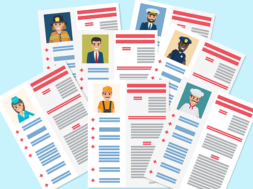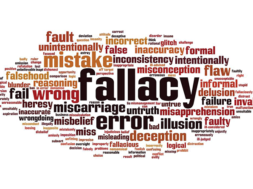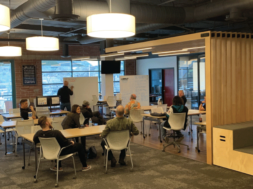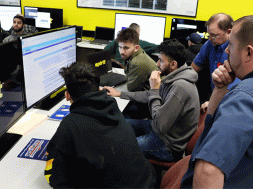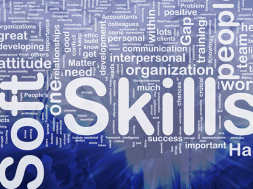
Game Changer! 4 Pillars of Placement Success
By Micaela Alpers, President, Career TEAM
As the Department of Education shifts its focus to the gainful employment of graduates, there has never been a more pressing time to ensure that the career services function of every private sector institution is running at full capacity.
Fast Fact: The job search process is undergoing massive change as personal branding becomes essential; meaning career services must become brand ambassadors…or face extinction.
As changes in the economy and advances in technology have disrupted traditional business practices, we must learn that our graduates are our product and employers are our ultimate customer. As such, career services should continuously innovate their approach to provide best in class support to graduates, and more importantly – employers.
In this article, we are going to explore four strategies (pillars) that have allowed placement teams to thrive despite challenges in the economy, and the constant battle of doing more with less. We all want students to be better informed, more assured and compelled to share their educational experience with others!
Pillar One: Talent (Fill the bus with the right players!)
Fast Fact: Human capital (people!) accounts for 85 percent of the value of a successful company.
Creating a winning culture starts by hiring outcomes oriented talent. Institutions stuck in the past often target a “career counselor” type to this role. These individuals tend to spend a disproportionate amount of time individually coaching students, and less time cultivating employer networks. During a recent conference presentation, we asked all the career services audience members how much time they spend with employers. The answer…5%…FIVE PERCENT! If we can all agree that employers are the ultimate customer of our institutions, this statistic is frighteningly low. But when we dig a little deeper, the reason for that 5 percent answer is often because these individuals are more comfortable working with students than hunting for employers…this is a hiring profile issue.
Fast Fact: The top 5 percent of career services functions spend 60 percent of their time in employer engagement, 30 percent preparing their students for interviews and assessments and 10 percent on administrative functions.
In a survey of over 10,000 placement professionals, it was determined that the following 5 attributes are key indicators to an individual’s success in a career services role: consultative sales approach, intrinsic curiosity, ability to confirm commitments, passion, and finally – DRIVE. The question then becomes, how do we know if someone is in possession of these skills before bringing them onboard? Here are two interviewing best practices that are sure to reduce a number of ‘oopsies’ hiring mistakes:
- Compare “apples to apples”
- Not “What would you do” but “What have you done”
Too often, a hiring manager approaches the interview without a clear idea of the ideal traits sought. They end up in a friendly conversation with the candidate, and the “emotional buying” takes over…sound familiar? Yes, it has happened to me, too. While I would never hire someone when something doesn’t feel right, making relationship based hiring decisions has backfired many times. The lesson: Skills first, relationship second.
What does it mean to compare apples to apples? Take an internal audit on the attributes that are consistent among your top performers (or borrow ours: consultative sales approach, intrinsic curiosity, ability to confirm commitments, passion, drive) and create a standardized interviewing template. Ask EVERY candidate the same list of questions for at least part of the interviewing process. By asking candidates the same questions, hiring managers are able to assess all candidates against the skills needed for the job, and not get sucked into the “emotional talent purchase.”
Why does it matter to ask questions in the “what have you done” format as opposed to “what would you do?” It’s simple. In a hypothetical world, we can answer for our hypothetical selves. Asking about real time situations will give you a much more realistic impression of how a person actually thinks or acts when the pressure is on.
Now, taking these two interviewing strategies into practice, let us review some examples of standard interviewing questions for career services:
Consultative Sales Style:
- Question: When you meet with a potential employer for the first time, walk me through your process?
- Assessment: What information do they gather before they present your school? Is there a systematic approach that covers criteria necessary to partner with that employer?
Emotional Intelligence/Intrinsic Curiosity:
- Question: How do you remain current on changes in your sector? How do you use that information to improve your strategy?
- Assessment: Are they curious and intelligent enough to proactively stay abreast of sector changes and use that information to drive customer needs, anticipate problems, and think outside the proverbial box for potential partnership options?
Fast Quote: “Customers are loyal to us right up to the moment somebody offers them better service.” – Jeff Bezos, Amazon
Confirming Commitments:
- Question: This one is easy…how did they close the interview?
- Assessment: Never EVER hire someone for a career services role that doesn’t close during the interview process. During the interview, you are getting the absolute best version of someone’s performance and can expect that to reduce once they are on the job. How they confirm commitments with you during the interview is indicative of how they will confirm commitments with candidates and employers. A series of confirming commitments throughout the interview process will indicate their ability to close the BIG DEAL.
Passion:
- Question: If you could have any job in any sector, what would it be?
- Assessment: This answer will not likely be “career services at XYZ institution,” but that is OK. What we are really looking for here is that their dream position is something that utilizes the same SKILLS needed to be a successful career services representative. If they answer with something like bookkeeping or administration they may be a better fit for another position on your openings list!
- Otherwise, there is a high likelihood of turnover for the next sales position.
It is also important that everyone in this role have a passion for students, and the lives that change within the four walls of our institutions.
Drive:
- Question: Tell me about a time that you failed at something and what you did next.
- Assessment: Missteps are inevitable. Someone willing to take accountability, however, is not as easy to come-by. What we want to hear here is someone that takes ownership of the “failure,” who recognizes what they learned from the mistake, and took steps to rectify the situation or make sure it didn’t happen again.
Not every candidate will come with a business development or career services background. These questions can be easily modified to uncover the same skills in someone with less or different experience. For example, if the candidate is a recent college graduate, substitute, “Tell me about a deal you really wanted and didn’t get” for “tell me about a team or organization you wanted to join, and weren’t selected.” Decisions and actions this person has taken their whole life will give you clues about their critical thinking skills and internal drive.
Take notice that Pillar 1 (Talent) is by far the longest piece of our discussion. And that is by design. As former President of McGraw Hill Higher Education, Brian Kibby often cited when discussing success, “talent, culture, strategy.” We could have the best technology, bulletproof processes, and excellent strategies, but without the right people in the right positions…we limit our outcomes.
Pillar 2: “You get what you inspect, NOT what you expect.”
With the right players on our team, it is now important to provide clear direction and continuous feedback on performance.
People want to do a good job, and more importantly, they want to know that they are doing a good job.
Having clearly defined goals and proper training demystifies the performance evaluation process and reduces uncertainty.
Fast Quote: “You are what you repeatedly do.” – Aristotle
As a manager of managers in my former role with McGraw Hill, I quickly learned how subjective “good performance” can be based on the opinions and values of an individual manager. Knowing this, I created both qualitative and quantitative performance documentation that was completed and reviewed with our account managers on a regular basis. For your benefit, there is a sample copy of a weekly qualitative and quantitative performance evaluation template for career services staff below.
| Performance Indicator | Goal | Achieved | Comments: |
| Employer Outbound Calls | 30 | ||
| On-site Employer Visits | 8 | ||
| On-site Hiring Events | 1 | ||
| Community Events (Chamber of Commerce Meetings, Young Professional Mixers, etc.) | 1 | ||
| Social Media Brand Building | 5 | ||
| Candidate Workshops (Dress for Success, Resume Writing, LinkedIn Tutorials) | 2 | ||
| Candidate Coaching Hours (Mock Interviews, etc.) | 5 | ||
What you probably noticed about this evaluation template is that most of the evaluation topics and time are EMPLOYER facing activities. That is by design, and indicative of an employer focused philosophy about the role of career services. Does your team have clearly defined metrics for success? If so, are they reviewed regularly? This is a LOT of work to establish, but once these processes are in place, true performance unveils and productivity ignites!
I recently contacted several of my executive level friends in the sector to better understand how they train their career services staff. What I found surprised me. Training for individuals in career services was almost nonexistent. When you consider the importance of career services on retention, placement, and student success outcomes of an institution, we should be concentrating our efforts to this area in terms of training. After all, career services team members are the BRAND AMBASSADORS of your organization with the ultimate customer – the employers!
How do we know if your team needs to be trained? Ask yourself the questions below. If you don’t have answers to any of these questions, I strongly suggest that you invest in their training…and fast!
- Do my career services team members meet with new potential employers regularly?
- Would everyone on the team know how to articulate our school’s mission, and the value of partnering with our institution at a Chamber of Commerce mixer?
- Are my team members easily searchable for potential employers and representing our school’s brand on social media sites like LinkedIn?
Mandatory training on employer engagement should be a day one requirement for any career services hire, with quarterly online or face-to-face training as a follow up. How they prepare for employer visits, uncover the needs, and present your institution as a valuable staffing solution is a skill that is developed over time. Below is a list of topics that should be included in an effective career services training program:
- Professional selling basics
- The employer interview – before, during, and after
- Creating an effective outreach campaign
- Public speaking and sales presentations
- Developing effective presentations and support materials
- Marketing strategies, including the use of social media
- Community outreach and building political rapport
- Administrative processes and tracking systems
Fast Fact: A survey of over 5,000 Workforce Development professionals across the country found that less than 10 percent of ALL placement staff members have been through any form of employer engagement or SALES training.
The skills set we are looking for here is a tall order! Not everyone needs to come to the team with a business development background, but if their intangibles were properly assessed during the interview process, they should be able to develop them quickly.
Pillar 3: Be different! Present your students the modern way…a personal branding approach
Fast Fact: There are now more mobile devices on earth than people! 84 percent believe that mobile phones are the most common way candidates will search for jobs within the next five years!
Stagnation by lack of innovation is a death knell! How does your staff introduce themselves and your school to potential employers? How do they introduce graduates to potential employers? Paper resumes, Career Fairs…a combo of both? That is a good start…and it is also how every other college is presenting their graduates to the same employers
Google has changed the way we consume information, the way we make buying decisions…even how people date (hello eHarmony and Match.com)! It has also changed the way employers hire candidates. Searching through stacks of paper resumes is time consuming and inefficient. As a hiring manager, I rely heavily on how well an individual has managed their personal branding. For example, I use LinkedIn to search for candidates for almost every new position I fill. I can easily find specific credentials, companies, and other qualifications I am looking for. This dramatically cuts down search times in the process.
Fast Fact: Over 90 percent of hiring authorities consider the candidates online presence when making a hiring decision.
Are you making it easy for employers to quickly identify that your graduates have the skills and credentials needed for their opportunity? When an employer Google’s your graduates (or career services staff member) will what they find represent the brand of your institution? If not, you should consider that every graduate must create a digital profile before graduation. There are different platforms that pertain to different industries, like GitHub.com for IT Professionals. LinkedIn.com is a very universal platform across all industries, and a place all your career services team members and graduates should be searchable for potential employers.
Fast Fact: Online profiles have replaced the traditional paper resume. “We can start by discarding the notion that paper will remain for long a big part of what we do, it will not.” – Martin Baron, Executive Editor of The Washington Post
Pillar 4: Soft skill development…a booster shots approach
Over the past decade, I have had an opportunity to attend numerous program advisory board meetings with different colleges across the country. The number one challenge cited by employers from coast to coast is soft-skill development. By and large, we are serving a population with multiple barriers to success. That said, it is surprising to me how many institutions offer a Career Success course in the last term before graduation. Even more perplexing are situations where career success is omitted from core curricula completely and instead schools are relying on non-mandatory workshops by career services to prepare students for employment. Only the students that don’t need the workshops are the ones that show up!
Fast Fact: 20 percent of students place themselves, 10 percent are extremely hard to place due to substantial barriers; the key is for career services to focus on the remaining 70 percent!
Private sector colleges and universities are exceptional at teaching the technical skills required to get a job, but as one career services Director recently said to me, “I can place an average skilled graduate with a great attitude over a highly skilled graduate with weaker soft skills every day.” In other words, we are great at teaching our college students the skills they need to attain a job but not the professional development skills that will allow them to keep it. The two sides have become disconnected.
Many institutions are moving away from a linear approach of: admission, to academics, and finally, placement to an integrated approach where soft-skills and professional development are woven into the student experience from Day 1. This population is prone to impulsive decision making. Once the rigor of core curriculum sets in, it becomes even more important to circle back to the WHY behind the certificate or degree, and remind them (booster shots) about their ultimate objective.
Incorporating professional development into core curriculum throughout the student’s academic experience allows these skills to mature overtime, AND bolster retention rates in the process.
To conclude our discussion about the 4 Pillars of Placement Success, it is important to note that placement outcomes are not just the role of career services. It is an institutional decision, an initiative that requires cross functional commitment across all departments to bring a careering focus to every level of the organization. It starts by having a foundation – the right people on your placement roster, ensuring that they have the training and tools to do the job, and finally, ensuring that students are properly prepared and branded for success!
Fast Quote: “The higher your structure, the deeper the foundation must be.” – St. Augustine

Micaela Alpers joins Career TEAM after 8 years in Higher Education publishing. Most recently, she served as National Director of Sales for McGraw Hill Education.
Micaela brings a background in higher education, coaching, and career development to Career TEAM. She completed the Accomplishment Coaching training program in 2013 and she is also a certified trainer in the Aha! Process, Bridges Out Of Poverty program. She is also a Cum Laude Graduate of San Diego State University with a degree in International Business.
Micaela has observed the Department of Education’s shift toward the gainful employment of our graduates. As such, she is most excited about exploring new ways of sharing CAREER TEAM’S 20 years of Workforce Development experience with partner institutions and, ultimately, with graduates.
Contact Information:Micaela Alpers // President // Career TEAM // 619-559-8134 // micaela@careerteam.com

